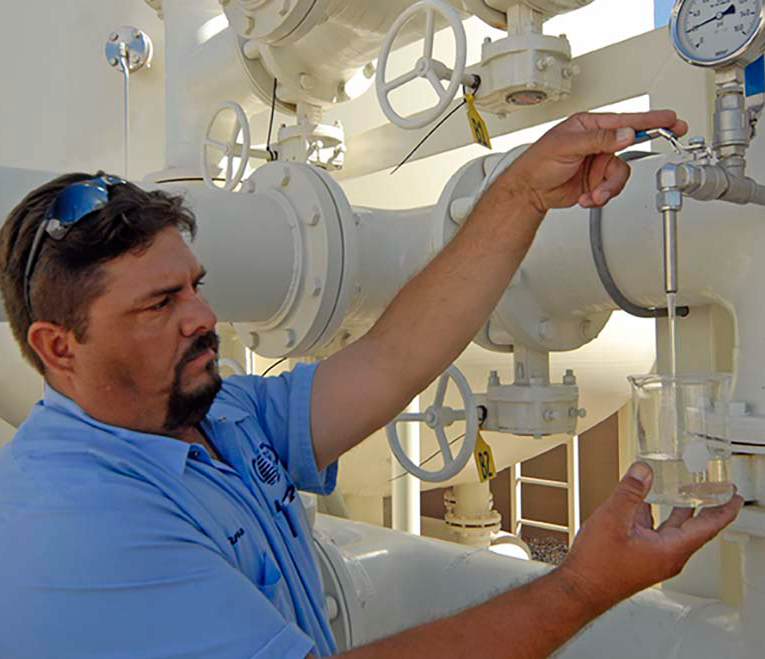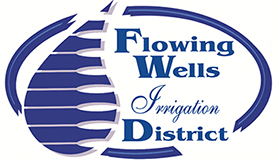
Flowing Wells Irrigation District
Annual Water Quality Report
for Calendar Year 2024
Este informe contiene informactión muy importante sobre el aqua usted bebe.
Tradúscalo ó hable con alguien que lo entienda bien.
https://espanol.epa.gov/espanol/recursos-e-informacion-sobre-el-ccr-para-los-consumidores
PWSID# AZ04-10051
This is our annual report about your drinking water quality, also called a Consumer Confidence Report or CCR. Having clean, safe water is one of the most important services we provide, and we want you to be as informed as possible about your drinking water.
This report provides you with information about where your water comes from, results of sampling that we have performed, and any issues or violations that happened over the previous year. This water quality report includes a table with the most recent water testing results within the last 5 years. The table shows if different germs and chemicals were in a safe range and met the health standards of the Environmental Protection Agency (EPA). Look for the column in the table called “TT or MCL violation,” to see if your utility found unsafe levels of any germs or chemicals.
You may also find real-time information about our water system at the Arizona Department of Environmental Quality (ADEQ)
Drinking Water Watch website at: https://azsdwis.azdeq.gov/DWW_EXT/.
Contact Us
We want our valued customers to be informed about their water quality. If you would like to learn more about public participation or to attend any of our regularly scheduled meetings, please contact us for additional information.
| Contact Name and Title | Phone Number | E-mail Address |
|---|---|---|
| Richard Rubal, Certified Operator | 520-887-4192 | customerservice@fwid.org |
Drinking Water Sources
The sources of drinking water (both tap and bottled water) include rivers, lakes, streams, ponds, reservoirs, springs, and wells. As
water travels over the surface of the land or through the ground, it dissolves naturally occurring minerals and can pick up substances
resulting from the presence of animals, human activity, or radioactive material.
Our water source(s):
Our water system has 9 wells that draw water from the Upper Santa Cruz sub-basin of the Tucson Active Management Area basin.

Source Water Assessment
Making the water safe to drink starts by protecting the place it comes from. We work with state scientists at ADEQ to examine water at its source to look for possible pollutants. We examine the hydrogeological nature of the land surrounding the water source and focus on how well the water source is protected from contamination. This is called a Source Water Assessment (SWA).
Our system has not yet received a SWA because we either did not exist when ADEQ last conducted assessments, were inactive, received all our water from another provider at that time, or ADEQ did not conduct an assessment for our system.
Further SWA information can be found on ADEQ’s website: https://azdeq.gov/source-water-protection.
Requests for further SWA information may also be sent to ADEQ via email at: sourcewaterprotection@azdeq.gov.
Drinking Water Contaminants
Contaminants are any physical, chemical, biological, or radiological substance or matter in water. Contaminants that may be present in source water include:
Microbial Contaminants: Viruses and bacteria that may come
from sewage treatment plants, septic systems, agricultural livestock
operations, and wildlife.
Disinfectants and Disinfection By-products: Water additives used
to control microbes, and the by-products of interactions between
disinfectants and natural organic materials in water.
Inorganic Contaminants: Salts, metals, and other inorganic
contaminants that can occur naturally or result from urban stormwater
runoff, industrial or domestic wastewater discharges, oil and gas
production, mining, or farming.
Pesticides and Herbicides: Synthetic organic compounds that
come from agriculture, urban storm water runoff, and a wide
variety of residential uses.
Organic Chemical Contaminants: Synthetic and volatile organic
chemical by-products that come from industrial processes,
petroleum production, gas stations, urban storm water runoff, and
septic systems.
Radioactive Contaminants: Can be naturally occurring or be the
result of oil and gas production and mining activities.
Vulnerable Population
Drinking water, including bottled water, may reasonably be expected to contain at least small amounts of some contaminants. The presence of contaminants does not necessarily indicate that water poses a health risk. In order to ensure that tap water is safe to drink, the EPA prescribes regulations which limit the amount of certain contaminants in water provided by public water systems. The Food and Drug Administration (FDA) regulations establish limits for contaminants in bottled water which must provide the same protection for public health.
Some people may be more vulnerable to contaminants in drinking water than the general population. Immuno-compromised persons such as persons with cancer undergoing chemotherapy, persons who have undergone organ transplants, people with HIV/AIDS or other immune system disorders, some elderly, and infants can be particularly at risk from infections. These people should seek advice about drinking water from their health care providers.
More information about contaminants, their potential health effects, and the appropriate means to lessen the risk can be obtained by calling the EPA’s Safe Drinking Water Hotline at 800-426-4791 or visiting the website epa.gov/safewater.
Lead Informational Statement:
Lead can cause serious health problems, especially for pregnant women and young children. Lead in drinking water is primarily from materials and components associated with service lines and home plumbing.
Flowing Wells Irrigation District is responsible for providing high quality drinking water and removing lead pipes, but cannot control the variety of materials used in plumbing components in your home. You share the responsibility for protecting yourself and your family from the lead in your home plumbing. You can take responsibility by identifying and removing lead materials within your home plumbing and taking steps to reduce your family’s risk.
Before drinking tap water, flush your pipes for several minutes by running your tap, taking a shower, doing laundry or a load of
dishes. You can also use a filter certified by an American National Standards Institute accredited certifier to reduce lead in drinking water.
To address lead in drinking water, public water systems were required to develop and maintain an inventory of service line materials by Oct 16, 2024. Developing an inventory and identifying the location of lead service lines (LSL) is the first step for beginning LSL replacement and protecting public health. Please contact us if you would like more information about the inventory or any lead sampling that has been done.
If you are concerned about lead in your water and wish to learn about testing your water, please contact us. Information on lead in drinking water, testing methods, and steps you can take to minimize exposure is also available at:
epa.gov/safewater/lead.

Water Quality Data – Regulated Contaminants
The following terms are related to water quality data presented in the following table(s):
Action Level (AL): The concentration of a contaminant which, if exceeded, triggers treatment, or other requirements.
Maximum Contaminant Level (MCL): The highest level of a contaminant that is allowed in drinking water.
Maximum Contaminant Level Goal MCLG): The level of a contaminant in drinking water below which no known or expected risk to health exists.
Maximum Residual Disinfectant Level (MRDL): The level of disinfectant added for water treatment that may not be exceeded at the consumer’s tap.
Maximum Residual Disinfectant Level Goal (MRDLG): The level of disinfectant added for treatment at which no known or
anticipated adverse effect on health of persons would occur.
Minimum Reporting Limit (MRL): The smallest measured concentration of a substance that can be reliably measured by a given analytical method.
Not Applicable (NA): The EPA has not established a MCL and/or a MCLG for this contaminant.
Picocuries per liter (pCi/L): Measure of the radioactivity in water.
ppm: Parts per million or Milligrams per liter (mg/L) ppm = 1000 x ppb
ppb: Parts per billion or Micrograms per liter (μg/L) ppb = 1000 x ppt
ppt: Parts per trillion or Nanograms per liter (ng/L)
The following water quality data only contain results for detected contaminants in your drinking water. Some results are from earlier years than the current year. This is because, according to regulation, some contaminants are monitored less frequently than once per year. The most recent results are shown in the table.
| Disinfectants | MRDL Violation? | Average | Range | MRDL | MRDLG | Sample Date | Likely Source of Contamination |
|---|---|---|---|---|---|---|---|
| Chlorine/Chloramine (ppm) | N | 0.48 | 0.37 to 0.65 | 4 | 4 | 2024 | Water additive used to control microbes |
| Disinfection By-Products | MCL Violation? | Highest Location Average | Range | MCL | MCLG | Sample Date | Likely Source of Contamination |
|---|---|---|---|---|---|---|---|
| Total Trihalomethanes (TTHM) (ppb) | N | 6.2 | 0.7 to 11.8 | 80 | N/A | 2024 | Byproduct of drinking water disinfection |
| Lead & Copper | AL Violation? | 90th Percentile | Number of Samples Exceeding the AL | AL | MCLG | Sample Date | Likely Source of Contamination |
|---|---|---|---|---|---|---|---|
| Copper (ppm) | N | 0.10 | 1 | 1.3 | 1.3 | 7/2022 | Corrosion of household plumbing systems; erosion of natural deposits |
| Radionuclides | MCL Violation? | Average or Highest Level Detected | Range | MCL | MCLG | Sample Date | Likely Source of Contamination |
|---|---|---|---|---|---|---|---|
| Alpha Emitters including uranium (pCi/L) | N | 3 | 0 to 3 | 15 | 0 | 2/2022 | Erosion of natural deposits |
| Inorganic Chemicals (IOC) | MCL Violation? | Average or Highest Level Detected | Range | MCL | MCLG | Sample Date | Likely Source of Contamination |
|---|---|---|---|---|---|---|---|
| Arsenic (ppb) | N | 6.2 | 1.2 to 6.2 | 10 | 0 | 2021-2024 | Erosion of natural deposits, runoff from orchards, runoff from glass and electronics production wastes |
| Barium (ppm) | N | 0.12 | 0 to 0.12 | 2 | 2 | 1/2021 | Discharge of drilling wastes; discharge from metal refineries; Erosion of natural deposits |
| Chromium (ppb) | N | 4.3 | 0 to 4.3 | 100 | 100 | 1/2021 | Discharge from steel and pulp mills; Erosion of natural deposits |
| Fluoride (ppm) | N | 0.53 | 0 to 0.53 | 4 | 4 | 1/2021 | Erosion of natural deposits; water additive which promotes strong teeth; fertilizer/aluminum factories |
| Nitrate (ppm) | N | 4.7 | 1.3 to 4.7 | 10 | 10 | 3/2021 | Runoff from fertilizer use; leaching from septic tanks, sewage; erosion of natural deposits |
| Selenium (ppb) | N | 2 | 0 to 2 | 50 | 50 | 1/2021 | Discharge from petroleum and metal refineries; erosion of natural deposits; discharge from mines |
| Sodium (ppm) | N | 310 | 25 to 310 | N/A | N/A | 2021-2024 | Erosion of natural deposits |
Water Quality Table – Unregulated Contaminant Monitoring Rule (Required Reporting)
In 2023 your drinking water was sampled for the presence and concentration of 29 different per- and polyfluoroalkyl substances (PFAS). PFAS are man-made chemicals that are resistant to heat, water, and oil. They have been used since the 1940s to manufacture various consumer products, including fire-fighting foam and stain resistant, water-resistant, and non-stick items. Many PFAS do not break down easily and can build up in people, animals, and the environment over time. Scientific studies have shown that exposure to certain PFAS can be harmful to people and animals, depending on the level and duration of exposure.
To learn more about this group of chemicals, we encourage you to visit the ADEQ website at:
azdeq.gov/pfas-resources.
You may also read the ADEQ-provided “PFAS 101 Fact Sheet” or view ADEQ’s Introduction to PFAS video on YouTube at:
youtube.com/watch?v=t44kSh0uKXE
In 2027, six of the PFAS compounds will become regulated contaminants with the following proposed MCL’s:
| Per- and Polyfluoroalkyl Substances (PFAS) | Proposed MCL | MRL | Definitions |
|---|---|---|---|
| Perfluorooctanoic acid (PFOA) (ppt) | 4.0 ppt | 4 | * Hazard Index (HI): The Hazard Index MCL represents the maximum level for mixtures of PFNA, PFHxS, HFPO-DA, and/or PFBS allowed in water delivered by a public water system. A Hazard Index greater than 1 indicates potential health concerns and requires a system to take action. * Health-Based Water Concentration (HBWC): The HBWC for a compound is the level at which no health effects are expected. For PFNA, PFHxS, and HFPO DA, the HBWC is the same as the MCL. PFBS, while having no MCL individually, does have a HBWC. The Hazard Index is calculated using the HBWC's (see below) Low levels of multiple PFAS that individually would not likely result in adverse health effects may pose health concerns when combined in a mixture. The Hazard Index for PFNA, PFHxS, HFPO DA, and PFBS compounds is calculated by summing the ratios of each compound's measured concentration in drinking water to its HBWC. For example, if the lab results (ppt) came in as follows: 3.2 for PFNA, 3.7 for PFHxS, 5.5 for HFPO DA, and 16.3 for PFBS, the calcuated HI = (3.2/10) + (3.7/10) + (5.5/10) + (16.3/2000) = 1.5 |
| Perfluorooctanesulfonic acid (PFOS) (ppt) | 4.0 ppt | 4 | |
| Perfluorononanoic acid (PFNA)* (ppt) | 10 ppt (MCL=HBWC) | 4 | |
| Perfluorohexanesulfonic acid (PFHxS)* (ppt) | 10 ppt (MCL=HBWC) | 3 | |
| Hexafluoropropylene oxide dimer acid (HFPO DA) (GenX chemicals)* (ppt) | 10 ppt (MCL=HBWC) | 5 | |
| Perfluorobutanesulfonic acid (PFBS)* (ppt) | HBWC = 2000 ppt | 3 | |
| Calculated Hazard Index (HI) | 1 (no units) * | N/A |
Your drinking water was also tested for lithium. Lithium is a naturally occurring metal that may concentrate in brine waters; lithium salts are used as pharmaceuticals, in electrochemical cells and batteries, and in organic syntheses.
| Metals | Average | Range | Sampling Date | MRL | Analytical Methods |
|---|---|---|---|---|---|
| Lithium (ppb) | 72 | 0 to 228 | 2023 | 9 | EPA 200.7, SM 3120 B, ASTM D1976–20 |
The following PFAS compounds were detected in your drinking water:
| Per- and Polyfluoroalkyl Substances (PFAS) | Average | Range | Sampling Date | MRL | Analytical Methods |
|---|---|---|---|---|---|
| Perfluorobutanesulfonic acid (PFBS)* (ppt) | 0.67 | 0 to 4 | 2023 | 3 | EPA 533 |
| Perfluorooctanesulfonic acid (PFOS) (ppt) | 0.83 | 0 to 6 | 2023 | 4 | EPA 533 |
| Perfluorooctanoic acid (PFOA) (ppt) | 0.83 | 0 to 5 | 2023 | 4 | EPA 533 |
| Perfluorohexanesulfonic acid (PFHxS)* (ppt) | 2.50 | 0 to 9 | 2023 | 3 | EPA 533 |
| Perfluorohexanoic acid (PFHxA) (ppt) | 0.50 | 0 to 3 | 2023 | 3 | EPA 533 |
| Perfluoropentanoic acid (PFPeA) (ppt) | 0.58 | 0 to 4 | 2023 | 3 | EPA 533 |
Violation Summary
Please share this information with other people who drink this water, especially those who may not have received this notice directly (for example, people in apartments, nursing homes, schools, and businesses). You can do this by posting this notice in a public place or distributing copies by hand or mail.
| Violation Type | Explaination, Health Effects | Time Period | Corrective Actions |
|---|---|---|---|
| 1) Missed monitoring | We missed our 1st quarter sampling in 2024 for Disinfection Byproducts (Total Trihalomethanes and Haloacetic Acids). See below for health effects. | 1st Quarter 2024 | Violation closed with submission of 2nd Quarter sampling. |
| Some people who drink water containing trihalomethanes in excess of the MCL over many years may experience problems with their liver, kidneys, or central nervous systems, and may have an increased risk of getting cancer. Some people who drink water containing haloacetic acids in excess of the MCL over many years may have an increased risk of getting cancer. Because we missed monitoring for these contaminants in the first quarter of 2024, we cannot be certain of the safety of your drinking water during that time. That said, the concentration of these contaminants is highest during the summer (3rd quarter), and your drinking water consistently falls well below the maximum contaminant level for these contaminants year-round |
|||
| 2) Late reporting | We were late submitting our initial inventory of service line materials for the new EPA rule requiring water systems to check for lead in all system service lines - no health effects. | October 2024 | Completed the inventory and closed out the violations. Public Notice required. |
| 3) Missed Public Notice deadline for #2, above. | We did not submit the required Public Notice regarding our late inventory submission by the due date. | December 2024 | We are including the Public Notice in this report, here, which will close this violation. |


If you would like a copy of this report mailed to you, please call, stop by, or email the office and we will be happy to get one to you or
click here for a downloadable copy (PDF format).
Please share this information with other people who drink this water, especially those who may not have received this notice directly (for example, people in apartments, nursing homes, schools, and businesses). You can do this by posting this notice in a public place or distributing copies by hand or mail.